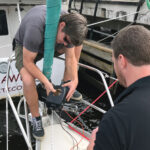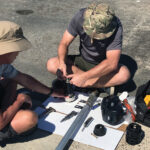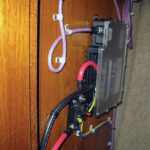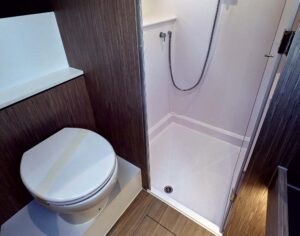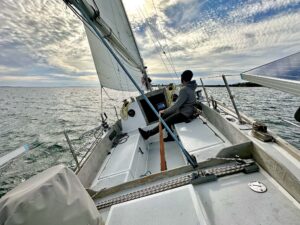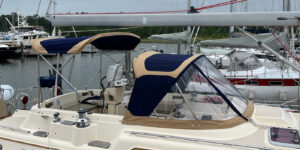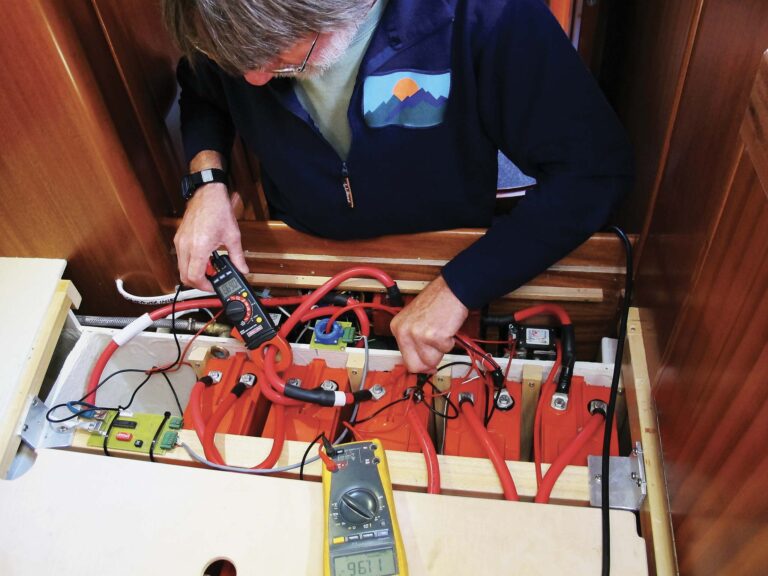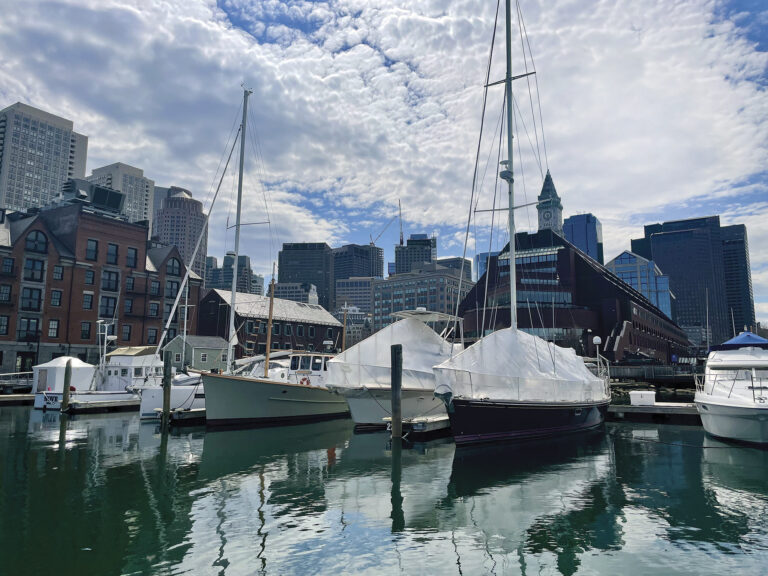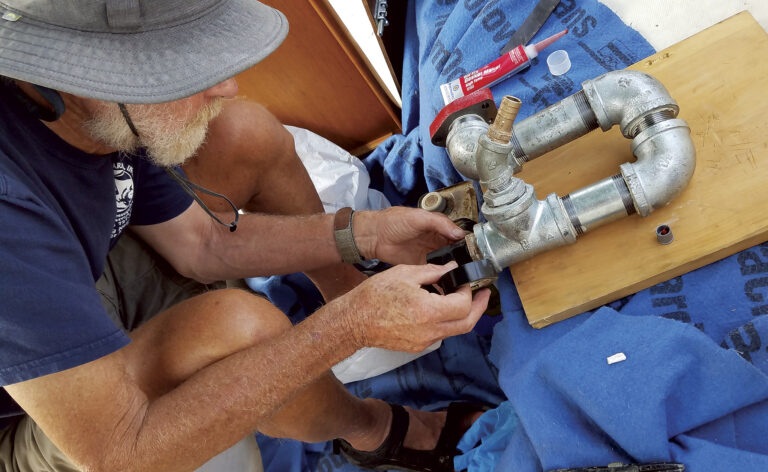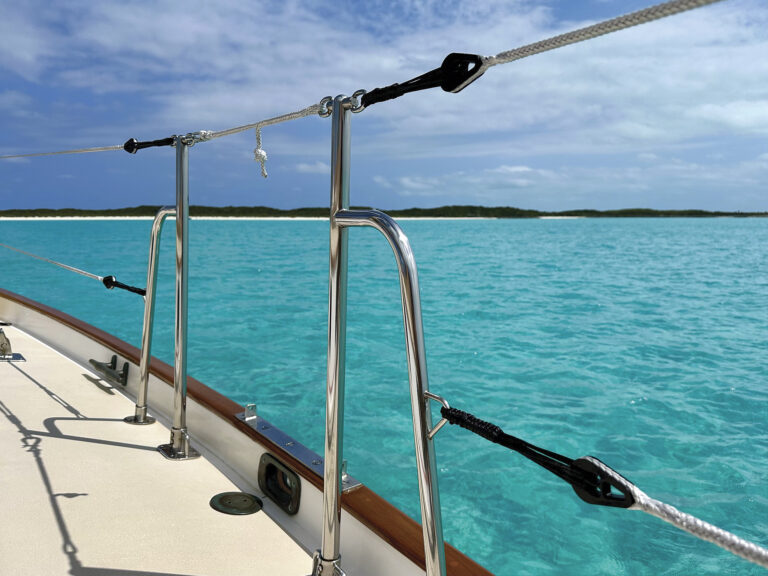Push-Button Reefing

Boats have never been easier to sail, and yet, designers and builders still strive for that extra iota or two of convenience. A case in point is the growing acceptance of powered headsail furlers. Roller-furling headsails are ubiquitous not only on cruising boats, but on many of today’s racing boats. It’s a logical leap to assume that if a sail that can be rolled away manually is a boon to sailors, one that can be controlled by a motorized furler is even more so.
There’s nothing new about motorized furlers. Electric and hydraulic variants have been around for decades. I had my first brush with them on a winter delivery in the North Sea some 25 years ago. That ended badly after water got into a poorly sealed junction box one dirty night, shorted out the electrics and left the sail stuck half out. It was in shreds by the time I’d rolled it away with a winch handle as waves washed over me. It’s episodes like this that stick in sailors’ minds and lead them to condemn the technology, which is kind of unfair; I’ve had a manual furling system jam up with the same result, thanks to an override on the furling line, and it was a lot harder to deal with.

Naturally enough it was the big-boat crowd that embraced powered furlers with open arms; rolling up a flogging genoa when you’re overpowered in a rising gale is a gnarly enough job on a 40-footer, let alone on a shorthanded 50- or 60-footer. Speed is of the essence in such situations to avoid damage to the sail, which always loads up in a blow, and poor cousin Elmer, cranking away on the kind of undersized winch typically devoted to the furler, often takes way too long.
Sure, if the boat has powered primaries you can lead the furling line to one of them—as long as it’s on the same side of the boat and not occupied by the jib sheet, which is the case only about 50 percent of the time. That’s why a dedicated winch for the headsail makes sense—and the next step up from that is an electric furler.
Most furling-gear makers offer hydraulic and electric versions alongside their manual units, and electric units, in particular, are becoming more popular as retrofits to older boats. “If your boat already has a hydraulic motor on board—for instance, if you have a hydraulic bow thruster—then a hydraulic furler might make sense,” says Mark van Note, marketing manager for Wichard USA. A French company, Wichard owns Facnor and Profurl, which both have been making powered units for many years. “Otherwise, it’s too complicated to install one, which is why most retrofits, and indeed most OEM installations, are electric units.”
Furlex’s Scott Alexander says there’s little point in installing an electric furler on boats below around 35ft. “The uptake is on boats above 35ft where the sail plan is larger and the value of the boat justifies the cost of the upgrade,” he says.
As with any other boat goodie, the cost of upgrading to an electric furler can escalate far above the price of the components. Will you be replacing the headfoil, or can the motor be installed on the existing parts? What other rigging work will need to be done? Are you competent enough to do it yourself, or will you employ a rigger? What about the electrics? These are low-voltage motors, but the currents are high. You need to know what you’re doing—it may be more than just a simple matter of splicing into windlass or bow thruster power cables. You will also have to run cables aft from the control box to the switch gear, which will be at the helm.
The increasing popularity of electric winches and furling systems—not just for genoas but for mainsail furlers and light-air sails as well—is partly due to the increased electrical capacity of modern boats. They carry bigger battery banks than in the past and with most cruisers now adding solar panels to engine-generated power, the demands of yet another electric motor are not felt the way they were years ago. The 30 seconds or so of current at 60 amps that it takes to unroll a sail just isn’t a big factor anymore. After all, the engine is usually running when you’re making or striking sail. As Profurl says, the energy it takes to roll up a genoa is equivalent to running an incandescent light bulb for 20 minutes.
As for reliability, the various manufacturers have been making these units for long enough to sort out any bugs. With any marine electrical system, the devil’s in the details—making sure cables are properly sized and provided with overcurrent protection, connections are strong and watertight, and cable runs are properly secured.
Powered Furler Manufacturers
The following manufacturers produce both powered and manual furling systems

Bamar
Among other things, this Italian company builds bespoke furling systems and sail-handling equipment for superyachts, so its engineering chops are not in doubt. Bamar does not neglect the smaller end of the market and has recently introduced a new line of electric furlers for cruising boats from 40ft to 100ft. Built of anodized aluminum, the systems can be installed on forestays from 8mm to 32mm in diameter and are available as retrofits or complete systems with extrusions and swivels. The three models in the EJF range utilize an epicyclic transmission and an electromagnetic lock. Emergency operation is via a winch handle or electric winch. The smallest model, the EJF1C, draws 400W at 12 volts while the two larger models are only available in 24V versions and draw 900W and 1500W respectively. Rotation speed is 40rpm for the EJF1C and EJF2C and 35rpm for the EJF3C. Bamar’s “Boxtron” electronic controller is supplied separately, as is switching gear. The furlers can also be controlled wirelessly. Retail prices start at $12,500 for the EJF1C, with some parts supplied separately. Bamar, bamarusa.com
Facnor
Taking aim at boats from 30ft to around 60ft, French company Facnor’s electric furlers use 400- or 800-watt motors in either 12V or 24V configurations. Installing over the existing forestay and foils, the smaller EC39 and EC47 retrofit units can be used to convert any of Facnor’s three-manual furling systems. The EC39 fits 8mm or 10mm forestays; the EC47 is for 12mm forestays. Facnor claims rotation speeds of 45rpm for the smaller unit and 55rpm for the 800w unit, which should see a big genoa rolled away in 35 to 45 seconds. The hard-anodised aluminum motor housing conceals a bronze worm gear that locks in position. The upgrade package contains the motor, control box, circuit breaker and link plates for the chainplate fitting. You must buy your own switches; Facnor offers a wireless remote. Should power fail, the sail can be furled with a winch handle or an endless line furler (available separately) that clips into the drive unit. Facnor also offers two complete electric furling systems, the EF+550 and EF+600, for boats up to 60-plus feet. Pricing starts at $5,799 (full retail) for the EC39 system. Facnor, Facnor.com
Furlex
Swedish company Seldén Mast has been making electric versions of its popular manual Furlex systems for over 25 years. Its fourth-generation Furlex Electric units were introduced in 2018. The two new systems—the 204E and 304E—are suitable for boats from the mid-30ft range up to 60ft or so, either as straight swaps for existing manual furling drums or as complete packages including foils and headstay. They employ a DC to DC converter to step voltage from 12 or 24 volts to 48 volts. This eliminates the expense and weight penalty of running hefty power cables from the batteries to the furler. The two-speed motor drives a self-locking worm gear and the system has an integral current limiter that senses overloading and cuts the power until the control button is released. Should power fail, the sail can be rolled in or out with a line-drive drum. A larger unit, the 400E, is due early next year. A Furlex 304S manual furler can be upgraded to electric for around $3,400. Seldén Mast, seldenmast.com

Harken
Harken offers two sizes of its Mk IV electric furler to suit boats up to 60ft or so. Above that length, the company recommends installing one of its hydraulic furlers. The 2E version can be fitted to 8mm or 10mm 1 x 19 wire forestays or rod rigging up to 9.53mm, and is recommended for boats from 35ft to 43ft; the 3E, for boats up to 60ft, fits wire stays up to 12mm or rod to 9.53mm. Construction is of hard-anodized, UV-stabilized aluminum, with a 12V or 24V watt motor driving a high-reduction worm gear that locks under load to prevent the sail from unfurling. A crank handle (supplied) can be used to roll up the sail in the event of power loss (though Harken recommends using a cordless drill fitted with a winch handle bit). Either electric furler can be bought as an entire system or retrofitted as an upgrade to an existing Harken manual furling foil. They come with a control box, 40-amp circuit breaker and switches. Power cables are not supplied but the manual has recommendations for cable size. For a 2E system, retail prices start at around $12,179 (system) or $8,764 (upgrade). Harken, harken.com.
Profurl
Profurl is a part of France’s Wichard group. A pioneer of manual roller furling systems, Profurl was also an early adopter of motorized systems. The company offers eight variants of its ND electric furler systems; five in the Cruising range to suit boats from 40ft to 90ft with forestay diameters from 12.7mm to 19mm, and three in the Racing range for boats from 40ft to the low 60ft-range with rod rigging forestays from 10mm to 12.7mm. The difference between the NDEC (cruising) and NDER (racing) lines is cosmetic, with the racing versions having black-anodized motors and oval-profile extrusions. Both 12V (700W) and 24V (800W) versions are available. In the event of motor or electrical failure the sail can be furled or unfurled with a line drive unit controlled from the cockpit. List price for a complete NDE2 C350 system is around $9,375. Profurl, wichardamerica.com
Reckmann
For more than 30 years, German company Reckmann has built electric furling systems for boats from around 36ft to 70ft with forestay diameters up to 16mm. Their mechanical excellence is matched by their pricetags, and they can be found on Swans, Oysters, Baltics and other high-end boats—not to mention custom-built units for even bigger boats. The smaller EF90-2 employs an 800W Bosch motor and can be ordered in either 12V or 24V configurations, while the 1,200W EF90-3 is a 24V system. The motors are protected by stainless steel guards that are insulated from the marine grade aluminum housings to prevent corrosion. Each comes with headfoils and associated hardware, along with the control box and switch gear. A winch handle is used in the event of power failure. North American distributor is Euro Marine Trading, euromarinetrading.com. Cost depends on the boat, but starts around $19,000. Reckmann, reckmann.com
Installing an Electric Furler
So, what exactly is involved in installing an electric furling gear? If you’ve ever installed an electric windlass, part of the process will be familiar to you—you’ll be hooking up an electric motor to switches and a control box, running cables the length of the boat and adding an appropriately rated circuit breaker in the positive cable from the battery. That’s all simple enough, and if you’re a capable DIY-er you could do all that yourself. What’s not so simple for the DIY-er, as I found when watching Seldén Mast techies swap out a manual Furlex 304 with its electric equivalent, is the rest of it—the rigging component of the project.
The installation kit comes with a control box, a DC/DC converter, switch buttons, deck gland, assorted screws and hose clamps, the power cables (blue/yellow) and a data cable (SEL-Bus)—pretty much everything you need. You have to figure out what size toggles you need to connect the headstay to the chainplate.
“Now how does this work….” The Selden team gets to grips with the project
The forestay and headfoil have been dropped and the furling drum is being swapped out for the electric motor
That done, the forestay is replaced and the team throws its weight behind the attempt to insert the vital clevis pin in the toggle.
The motor control box must be kept dry. In this case it was located high up under the V-berth. The three wires go to the motor, the blue/yellow power cables and the mauve data cable run aft to the DC/DC converter.
The DC/DC converter and its circuit breaker were mounted in the hanging locker in the aft cabin, a short cable run from the batteries. Note the difference in the size of the cables going to and from the converter.
The electric motor is slightly smaller than the furling drum it replaces.
They were fitting the unit to a Pearson 39, and in addition to running cables through the boat they had to send a man up the mast to drop the forestay onto the dock so they could replace the line drum with the electric motor. No doubt a skilled boat owner could do this with the assistance of a knowledgeable friend or two, but most of us would be advised to employ the services of a rigger. A better (read easier) option would be to take on the project when the mast has been dropped for the winter.
The most irksome part of the project was running the power and data cables to the DC/DC converter via a circuitous route through the bowels of the boat. Even if you engaged a marine electrician to make the connections (as Seldén recommends), you could save a lot of money, regardless of furler make, by taking on this time-consuming task. But basically, it’s a plug-and-play scenario if you follow the excellent instructions and have an understanding of low-voltage electrics.
As soon as the Seldén guys declared themselves happy with the install, we took the boat out for a spin. The furler worked flawlessly; drawing around 20 amps, it unrolled the 110 percent jib in around 15 seconds. With the switches mounted on the bulkhead, the jib could easily be reefed or rolled away on either tack, one hand pressing a button, the other keeping tension on the sheet to ensure a tight roll. Knowing full well how hard it can be to manually reef a sail in a blow, I was beginning to appreciate the virtues of electric furling.
November 2019


